Let Me Practice on Your Big Day
 Many, many readers have read and commented either here on Groozi or privately to me about the post “Score This: Photog 1, Cheapskate 0”. We’ve all shared a good chuckle, perhaps to conceal our nervousness about the state of our industry. But any professional photographer will tell you that their business is being eroded as a result of inexpensive digital cameras that take amazingly good pictures and a growing attitude that, “those pictures are good enough.” Amateurization and crowdsourcing have combined to create an entire body of photography that can be had for a song, primarily because the creators of these images don’t realize the value of the images they have created.
Many, many readers have read and commented either here on Groozi or privately to me about the post “Score This: Photog 1, Cheapskate 0”. We’ve all shared a good chuckle, perhaps to conceal our nervousness about the state of our industry. But any professional photographer will tell you that their business is being eroded as a result of inexpensive digital cameras that take amazingly good pictures and a growing attitude that, “those pictures are good enough.” Amateurization and crowdsourcing have combined to create an entire body of photography that can be had for a song, primarily because the creators of these images don’t realize the value of the images they have created.
Photographer and author John Harrington wrote a blog post titled, “The REAL New Frugality – TIME [Magazine] Style” in which he talks about how an amateur photographer left about $2,700 on the table by selling a photo he took to TIME for its cover for $30!
Buyers of photography are becoming accustomed to the dropping prices for images. After being asked to use one of his iconic images in exchange for a credit line, Chicago photographer Joe Pobereskin recently blogged, “Do you ever wonder what a photo credit tastes like? How about this: do you ever wonder how many miles per photo credit (MPCs) your car gets? I do.” Read entire post. And even Seth Godin, today blogged, “The reality of digital content (lose the cookie, lose the fortune?)” in which he ponders the economic futures of photographers and writers in this digital age.
Katrin Eismann, chairwoman of the Masters in Digital Photography program at the School of Visual Arts in New York said in a New York Times article, “Can an amateur take a picture as good as a professional? Sure,” Ms. Eismann said. “Can they do it on demand? Can they do it again? Can they do it over and over? Can they do it when a scene isn’t that interesting?” And that, I think, pretty much is what separates the pros from the amateurs.
But no doubt, professional photography is changing. The cost of entry to the industry has dropped dramatically forcing pros to seek out ways to differentiate themselves from their competitors lest the product they produce becomes comoditized. They must ask themselves, “What value do I bring to the client that my competitors do not?” and then talk it up during that initial phone conversation when the prospective client calls.
Gallery owner and photography educator Thomas Werner recently brought this to my attention: The San Francisco Museum of Modern Art held a symposium to which examined the current state of photography. They posed a question to the 13 invited participants to the symposium’s central question: “Is photography over?” It’s fascinating reading.
Richard Anderson, photographer, digital standards expert and the driving force behind dpBestflow, was interviewed by Ethan Salwen for the “AfterCapture On Photography” blog recently. The post was titled, “It’s About Professionalism, Stupid” and is a good read.
Mr. Salwen closes with: “I agree with Anderson that this is the most exciting time in the history of photography. How one does or doesn’t make money in this golden age of photography will continue to be a challenge. But whether or not is focused on making money from photography, thoughtful photographers trying to make great images must continue to take advantage of evolving technologies. This requires addressing the craft of photography with professionalism.”
I thought I’d close this entry with something Barrie Spence brought to my attention in a comment to that “Score This…” post. This is an ad that appeared on Scotland’s Gumtree, which as far as I can tell, is sort of like the USA’s Craigslist. It too might elicit that same nervous laugh…
.

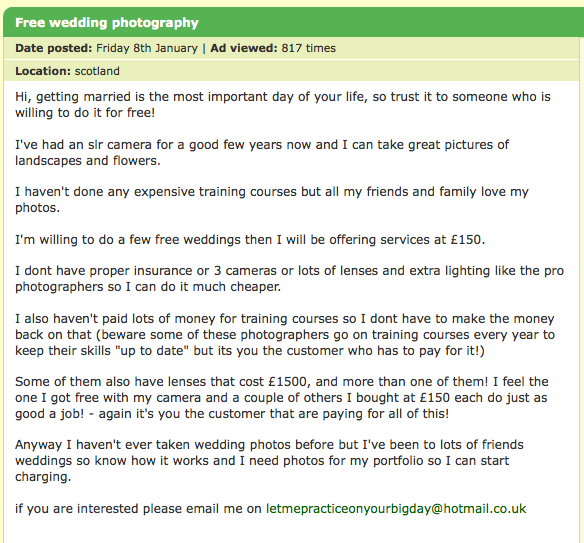
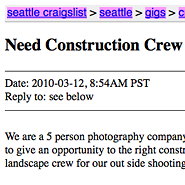 We’re all pretty tired of being asked to shoot on spec, shoot for a low fee with the promise of more work, and that sort of nonsense. These two ads appeared on the Seattle Craigslist over the past two days. I think you’ll enjoy reading…
We’re all pretty tired of being asked to shoot on spec, shoot for a low fee with the promise of more work, and that sort of nonsense. These two ads appeared on the Seattle Craigslist over the past two days. I think you’ll enjoy reading…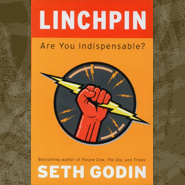 OK, I admit it, I have a Kindle and
OK, I admit it, I have a Kindle and 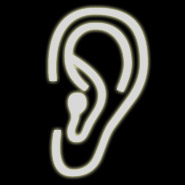 Somewhere I read this information and it has stuck with me through the years. I always think about it when someone calls about a photography job, but it applies to any sort of sales negotiation. Specifically, it’s the three pitfalls of listening.
Somewhere I read this information and it has stuck with me through the years. I always think about it when someone calls about a photography job, but it applies to any sort of sales negotiation. Specifically, it’s the three pitfalls of listening. When you’re knee deep in a negotiation with a client, things sometimes can go astray. That’s when perhaps your counterpart in the conversation is hammering you for a price concession, more licensing for less of a fee, etc. Next thing you know, you’re perspiring profusely and your talking faster and faster, starting to sound like Mickey Mouse, all because your emotions are taking over your normally clear thinking.
When you’re knee deep in a negotiation with a client, things sometimes can go astray. That’s when perhaps your counterpart in the conversation is hammering you for a price concession, more licensing for less of a fee, etc. Next thing you know, you’re perspiring profusely and your talking faster and faster, starting to sound like Mickey Mouse, all because your emotions are taking over your normally clear thinking.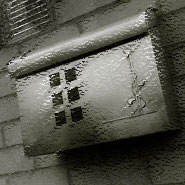
 groozi.com is a blog about negotiating and web marketing. Weekly posts are written primarily by me, Blake J. Discher, a
groozi.com is a blog about negotiating and web marketing. Weekly posts are written primarily by me, Blake J. Discher, a 
